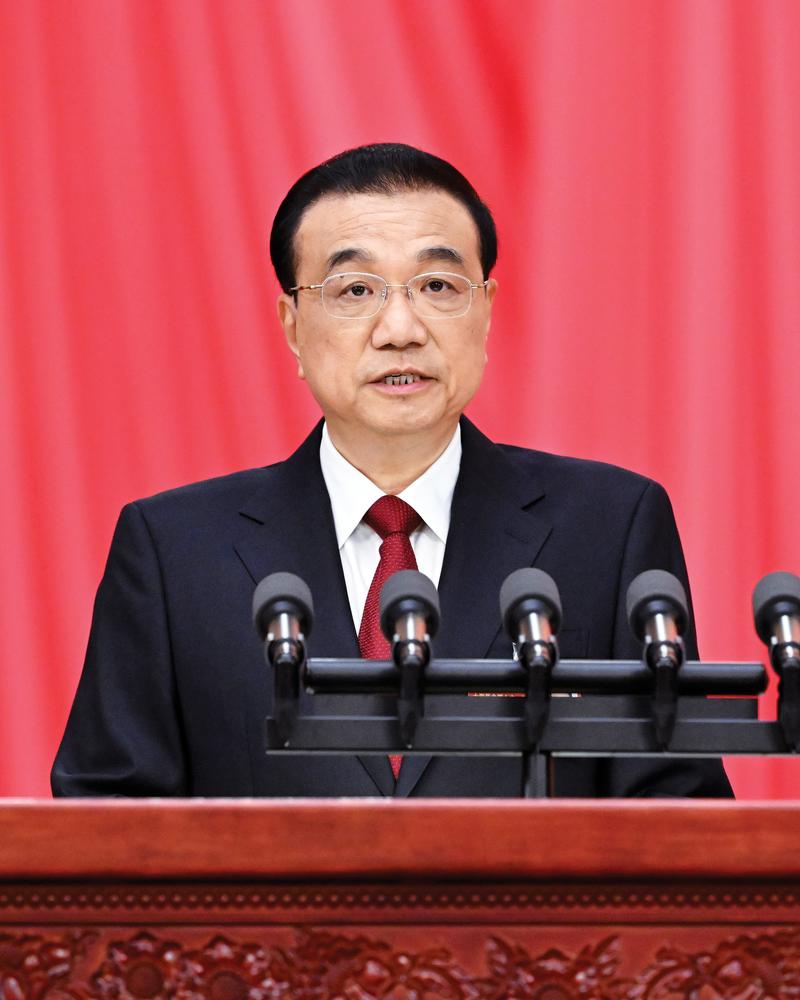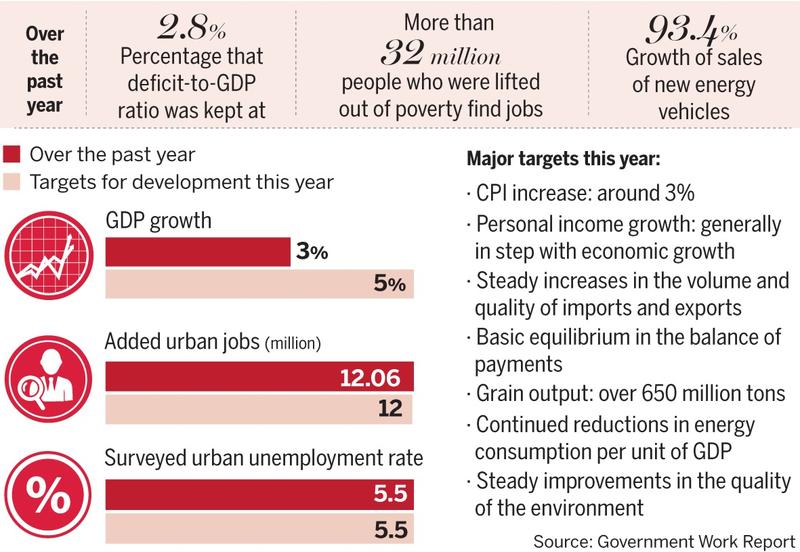China’s 2023 goal of around 5 percent growth achievable, leaves room for upside, experts say
 Premier Li Keqiang delivers the Government Work Report in Beijing on March 5. (PHOTO / XINHUA)
Premier Li Keqiang delivers the Government Work Report in Beijing on March 5. (PHOTO / XINHUA)
By Xin Zhiming, Liu Zhihua, Ouyang Shijia and Zhong Nan in Beijing, Prime Sarmiento and Xu Weiwei in Hong Kong, and Wang Xu in Tokyo
China has set its GDP growth target at around 5 percent for this year, which analysts said is “pragmatic” and “achievable”.
The real figure could turn out to be even higher, they said, suggesting that the country implement more targeted macroeconomic policies to boost consumption and prevent high inflation, in order to promote stable growth.
Analysts also said that China’s stable growth will help relieve global pressures as developed economies risk falling into recession while suffering from high inflation.
The growth target was revealed in the Government Work Report, which Premier Li Keqiang delivered at the opening meeting of the first session of the 14th National People’s Congress in Beijing on March 5.
President Xi Jinping, who is also general secretary of the Communist Party of China Central Committee and chairman of the Central Military Commission, attended the meeting.
The report, which has been submitted to the top legislature for deliberation, suggested that China push forward its modernization drive, promote high-quality development, ensure good balance in COVID-19 prevention and social and economic development, comprehensively deepen reform and opening-up, and vigorously boost market confidence.
China will enhance the intensity and effectiveness of a proactive fiscal policy and implement a prudent monetary policy in a targeted way, according to the Government Work Report.
Apart from suggesting the GDP growth target for this year, the report raised its projected deficit-to-GDP ratio to 3 percent and targeted an inflation rate of around 3 percent.
The country will aim to create around 12 million urban jobs this year and has set a target of around 5.5 percent for the surveyed urban unemployment rate.
China will also continue to encourage and support the development of the private sector and enhance efforts to attract foreign investment, according to the report.
Experts voiced strong confidence in China’s economic prospects despite the pressures and challenges ahead, saying the country can achieve the annual growth target amid improved domestic consumption and increased infrastructure spending.
Lu Ting, chief China economist at Nomura, said that China’s GDP growth target for 2023 is reasonable and rational, as the country’s economy is still expected to face multiple headwinds.
“We view it as a relatively conservative but pragmatic proposal for delivering a healthy and organic economic recovery from last year’s COVID disruptions, and we still see no sign of a massive stimulus program,” Lu said.
He said his team continues to expect China’s GDP growth to reach 5.3 percent this year, after 3 percent expansion last year.
Given China’s optimized COVID-19 response measures and the stability in its macro policies, Li Chao, chief economist at Zheshang Securities, estimated that China’s economy will likely expand by 5.1 percent in 2023, above the annual growth target.
“The GDP target is in line with the principle of ‘seeking progress while ensuring stable development’,” said Bai Jingming, a researcher at the Chinese Academy of Fiscal Sciences. “It is achievable and has left room for (coping with possible) risks.”
Compared with last year’s GDP growth of 3 percent, this year’s target is not high, given the strong rebound of consumption and initial recovery of investment after the country further optimized its COVID-19 response policy in January, Bai said.
“China’s growth target for this year is very pragmatic and will help consolidate the country’s economic fundamentals,” said Raymond Zhu, president of the East and Central China Committee of CPA Australia, a major accounting body.
Zhao Chenxin, deputy head of the National Development and Reform Commission, or NDRC, said setting an annual growth target of around
5 percent can help guide various parties to focus on ensuring better quality and performance while promoting economic growth, form a new development pattern and foster high-quality development.
China’s 31 provincial-level regions on its mainland have set their growth targets for 2023, with 27 of them setting their growth targets higher than the national one and 23 targeting at least 5.5 percent, Zhao said at a news conference in Beijing on March 6.
“Their (strong) confidence and pragmatic measures (to stabilize growth) have created conditions and laid a foundation for the nation to achieve its growth target this year,” Zhao said.

Zhao said the country will mainly focus on strengthening macro policy regulation, maintaining the continuity and consistency of macro policies and ensuring that the implementation of the strategy to expand domestic demand is integrated with efforts to deepen supply-side structural reform.
Speaking at the same news conference, Li Chunlin, another deputy head of the NDRC, said steps will be taken to stabilize spending on big-ticket items, boost consumption in the services sector, increase people’s incomes through multiple channels, and encourage green consumption and new types of consumption, as well as support consumption in key fields including housing and new energy vehicles.
Experts said Beijing’s pursuit of a new growth target and high-quality development will benefit not only the Chinese people but also the global economy.
Oh Ei Sun, senior fellow at the Singapore Institute of International Affairs, said he believes the 5 percent target is a “realistic one”, and noted that more interaction with Southeast Asian countries will help the region share China’s growth.
“The trade in goods has been very vibrant. The focus should now be on the trade in services, and also the outward investment in regional countries,” Oh said.
Khalid Taimur Akram, executive director of the Pakistan Research Center for a Community with Shared Future, said the Chinese leadership’s “center of focus is people”. The people-centric government work report has highlighted the milestones that were achieved, recognized current challenges and presented plans for advancement, he said.
Masanari Koike, a former member of Japan’s House of Representatives, said China’s GDP target is “aggressive” when compared with other large and developed economies. “But based on the fact that it is a little lower than the average of recent years, it seems not difficult to achieve,” he said.
Koike also said that China’s growth in the past decade had demonstrated the success of government strategies.
Anna Rosario Malindog-Uy, vice-president of external affairs for the Manila-based think tank Asian Century Philippines Strategic Studies, called the 5 percent target “conservative”, saying that China’s GDP growth this year will surpass that figure.
As an economic powerhouse, as well as the world’s largest trading country and largest market, China’s peaceful rise will benefit countries, especially those in the developing world, she said.
On March 3, Guo Weimin, spokesperson for the first session of the 14th National Committee of the Chinese People’s Political Consultative Conference, said China has solid foundations to grow its economy and will give top priority to achieving quality development this year.
While cautioning about headwinds such as continuous global political and economic instability, and spillover from policy adjustments in other major economies, Guo said China should continue to expand domestic demand to accelerate its recovery and spur consumption.
The nation will take concrete measures to promote opening-up and continue to provide new opportunities and drivers for global development, he said.
Economists suggested that given the many challenges faced by China, such as the economic downturn and high inflation in the developed world, the country needs to implement targeted macroeconomic policies to ensure stable growth.
“More efforts should be made to support, say, small and micro enterprises, promote private sectors to raise people’s incomes and boost their confidence, and support the foreign trade sectors, given the possibility of slower global growth,” said Zhou Maohua, a macroeconomic analyst at China Everbright Bank.
Zhang Yansheng, chief researcher at the China Center for International Economic Exchanges, said, “China needs to promote high-quality foreign trade development and improve the business environment, and the focus should be the negative list for the services industry.”
Despite multiple challenges, China remains an attractive market, a well-developed industrial cluster, and an increasingly efficient innovation hub for multinational corporations, said Lin Meng, director of the Modern Supply Chain Research Institute, which is part of the Beijing-based Chinese Academy of International Trade and Economic Cooperation.
Echoing that sentiment, Eddy Chan, senior vice-president of the US-based logistics firm FedEx Express, said China will play a more prominent role in driving global economic recovery and growth in the coming year.
Jeffery Liu, vice-president of US-based materials science company Corning, said his firm is bullish about China’s long-term prospects and sees huge growth potential in the ultra-large market.
Zhou Lanxu contributed to this story.
Contact the writers at xinzhiming@chinadaily.com.cn


